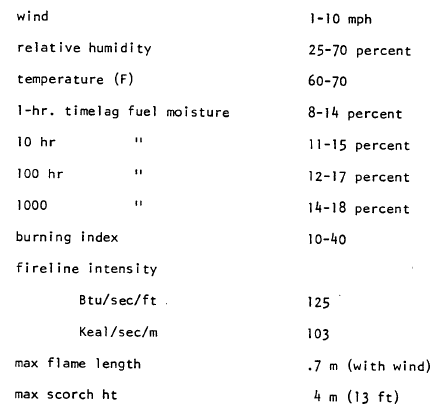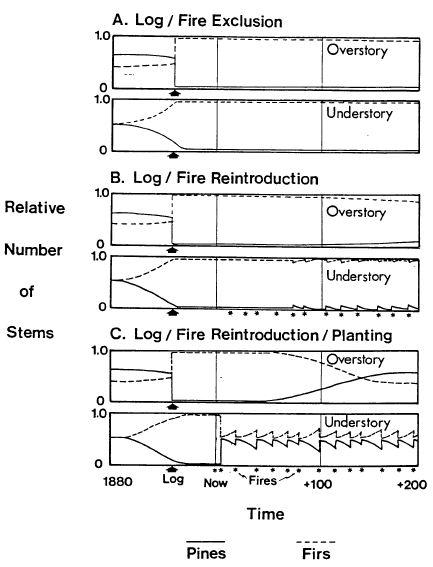Final Report, Forest Restoration of Sun Creek, Crater Lake National Park
Management Recommendations
Unlogged Areas
The Short Run
A significant proportion of the pre-fire suppression forest structure is still present in these areas. Reintroducing prescribed fire at low intensities will reduce fuels and much of the white fir density, particularly in the smaller height and diameter classes. The techniques suggested here are fairly standard and comparable to other mixed conifer recommendations (Van Wagtendonk, 1974). A prescription for these areas is presented in Table 4.* In the sugar pine area, a backing fire is recommended for the short run fires. In the ponderosa pine area, which has a gentler slope, strip headfires with strips 2-7 meters apart are recommended. Two fires in the next decade are recommended; the first will consume much dead fuel and kill much of the understory, and the second will consume the fuels created by the first fire and largely recreate a mimic of natural forest structure.
The Long Run
These areas are near the park boundary. Prescribed fire may be needed In the long run to simulate natural fires for two reasons. First, natural fires near the boundary may be somewhat unpredictable and require excessive monitoring. Second, some of the past natural ignitions came from outside the park, and these have been eliminated by current land use policies In those areas. A prescribed fire frequency should mimic the natural fire range of frequencies. For example, the average frequency was about 15 years. After the first two short run fires, this average frequency should prevail. Instead of a fire every 17.5 years, however, the intervals for the next 100 years should vary around the average: 20, 10, 15, 5, 25, 12, 18, etc., in a normal distribution.
The long run ecological consequences of this plan are illustrated by Figure 10. Under “A. Fire Exclusion” the present shift toward overstory and understory dominance by white fir will continue. Under “B. Fire Re-introduction,” an eventual shift back to natural conditions (the relative numbers in 1880, far left) will occur. The primary reason the overstory will take so long to recover is the current presence of large post-fire suppression white fir which will be only slightly affected by the reintroduced prescribed fires. The understory, once fire is reintroduced, will show a cyclic stability, with white fir relatively increasing between fires And pines relatively increasing at and right after fires.
 |
| Table 4. Fire prescription for unlogged areas. |
It should be noted that Figures 10, 11 and 13 are schematic in nature, and the future timeframes are not meant to be precise. They are suggested as long-term trends and goals towards which management actions should point.
 |
| Figure 10. Long term effects of management in unlogged areas. Under “A”, fire exclusion remains in effect. Under “B”, fire is reintroduced to the environment. |
Other pages in this section
*** previous title *** --- *** next title ***


